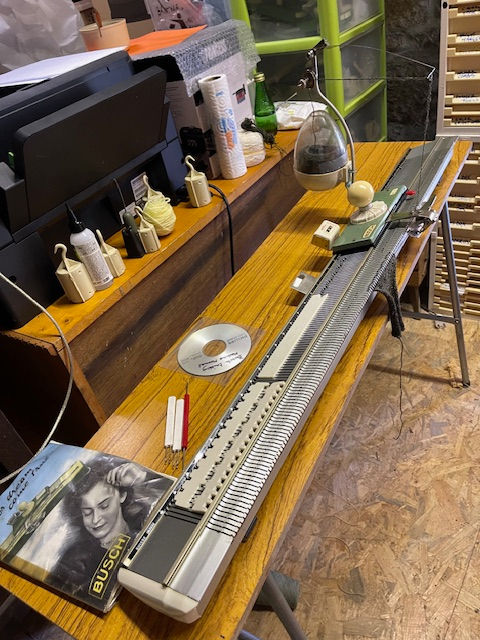Passap F200 Knitting Machine
- Maggi Bloice

- May 8, 2023
- 3 min read

Passap F200 Knitting Machine sometimes badged as a Corona
This is a unique Passap machine in that it is a 4.5 mm standard gauge single bed, The patterning system that was an optional extra and advertised as a Pattern Master. It is an attractive well built machine with heavy stainless steel sinkers which means that it does not require weights. The box which it was packaged in was an eyecatching design, with the machine featuring 2 colours, cream and pink. When I purchased the Passap it was relatively unused, as per most vintage machines, however my storage facilities have not helped to keep it in prime condition and I took it out for another look today. The yarn masts are square as opposed to the popular square posts of most machines. It has a clever tensioning system but I would image though it is excellent, it would have cost a bit to manufacture. I ran the carriage across the needles and it sort of purred, in other words, it shouts out quality.

The instruction manual though nothing special does the job and the cast on for this machine has to be the easiest I have ever encountered. The carriage is heavy and the system works by you, manually selecting the first few needles into position then you run the carriage across and it automatically selects the rest, how it works, I have no idea but it is good. The patterning system works on 8 needles, so for casting on, you simply select the first few needles into a one by one format and run the carriage across, then you do the same at the left side and again, run the carriage across and voila, your cast on is complete! You then pull the tail end of the yarn tight and you have a normal cast on. Of course there are settings to be set on the carriage but once done it is simply a case of cast on and knit for stocking stitch. With tuck stitches there are other carriage settings and once you set your needles up for the tuck stitch of your choice on the first few needles you simply take the carriage to the other side and do the same again and continue - I tried it successfully for 4 alternate tuck stitches and it knitted easily.

However the fun begins when you want to do a wee bit of fairisle - using the Pattern Master. I know this gadget is a good few years old and depends upon a clicker in the carriage hitting the clicker on the gadget to move the card up a row, however it does not always succeed and I had to do it manually and I know it probably is going to take something I lack, ie patience to make it work properly. Now we come to how it changes colours, and the carriage has two swing out yarn feeders, left and right and two subsidiary ones which can be used to hold yarn for more colours. The colour changing is done by threading both left and right feeders and one swings out of use whilst the other is knitting. The colour changes are always carried out on the right hand side - my thoughts were it would be an easy way to do stripes etc. According to the manual the machine also offers plating facilities for plain knitting with one colour at the front and one at the back. This is done in a similar way to weaving on modern machines.

The machine had suffered a bit in storage and needles were slipping, but there is no needle retainer bar in this machine so I simply unscrewed 4 tiny screws to take a look. The needles are retained with a thick wide piece of felt similar to carpet underlay. It was easy to remove from under 4 sprung bits of metal, so I slid it out carefully and took a look and could see where it was indented with staying in the same position, Ideally, I would have like to have access to another piece of felt but alas I had none, so I cut a bit of felted wool and pressed from the centre out under the two springs and managed to get it back into the case and screwed it down again. This was not ideal but it worked.

To summarise, it is a well built and fun machine but for me it would not suffice as a main machine because of the hassle of setting needles every row, and it is only an eight stitch patterning facility. I am sure it cost a small fortune to produce but like most vintage machines, I am not surprised it was nearly new and unused.
Do check out the youtube videos by theanswerladyknits on the Corona 1500 machine - its very similar to the Passap 200 and looks like a later model.























































































































😊cudowne opisy. Czytam po kilka razy o każdej maszynie. Bardzo dziękuję. To Muzeum to wspaniałe dzieło.